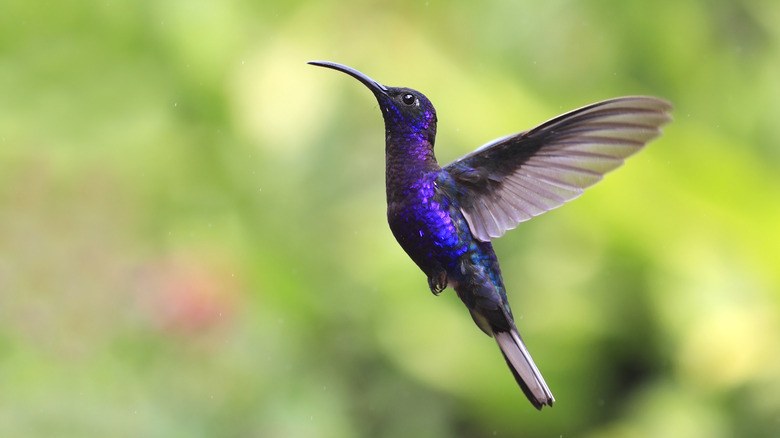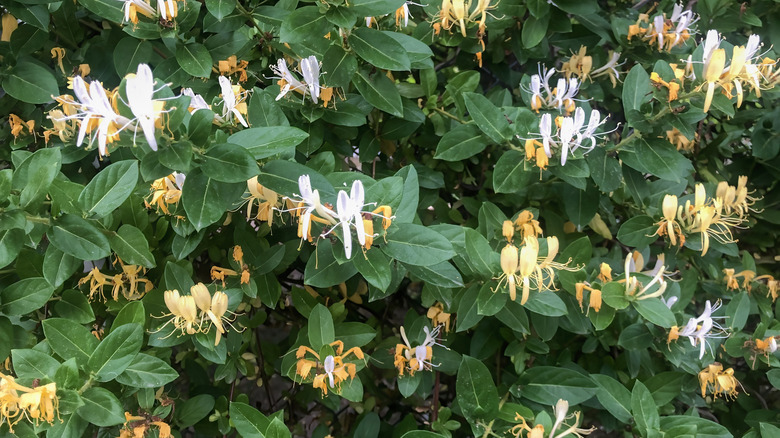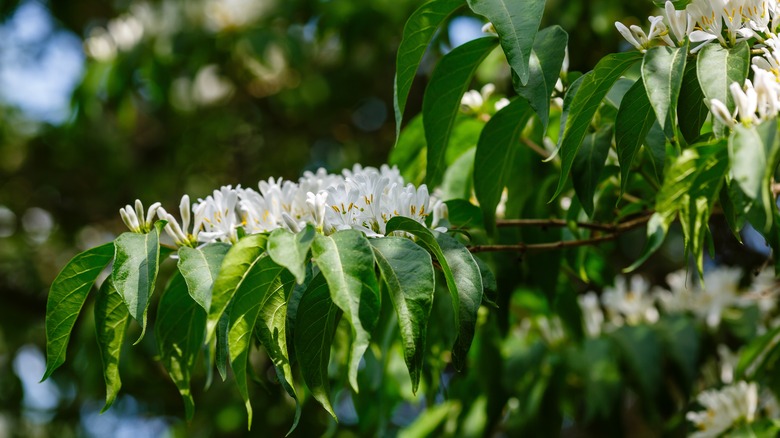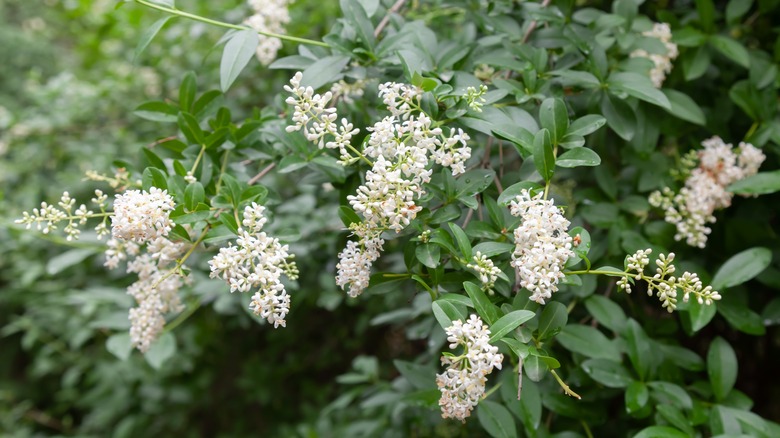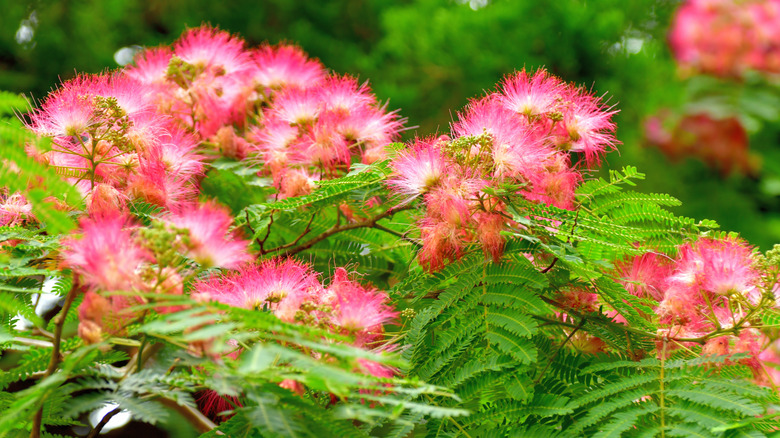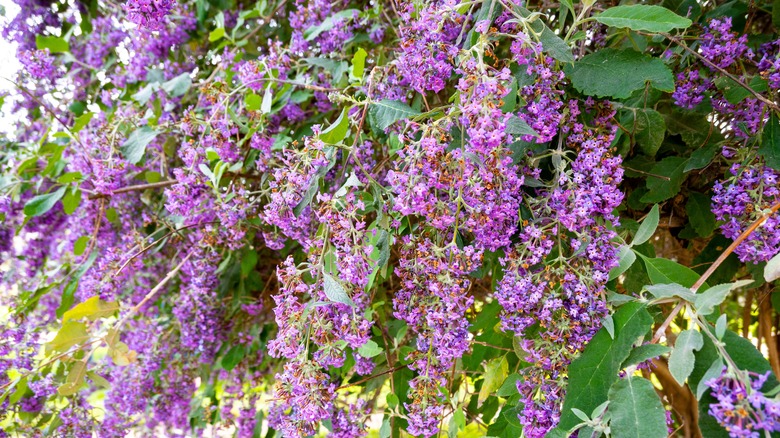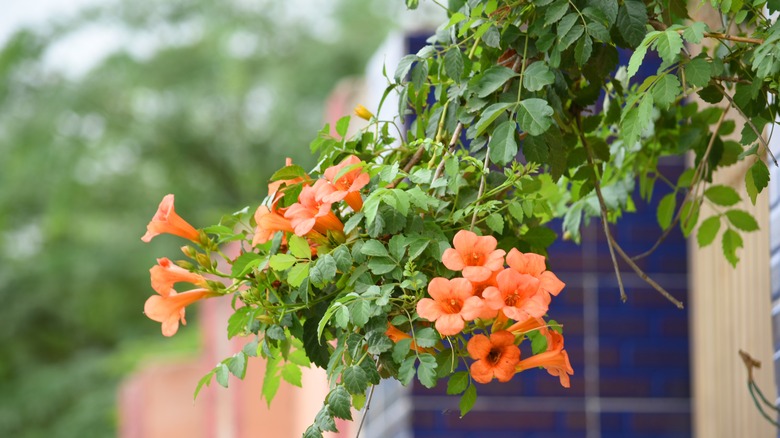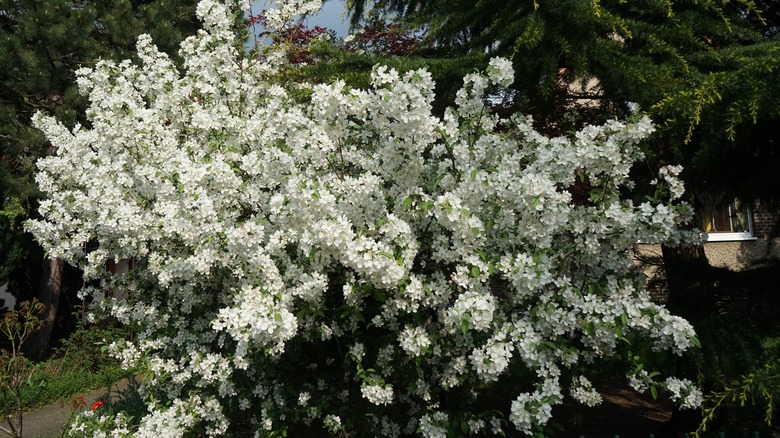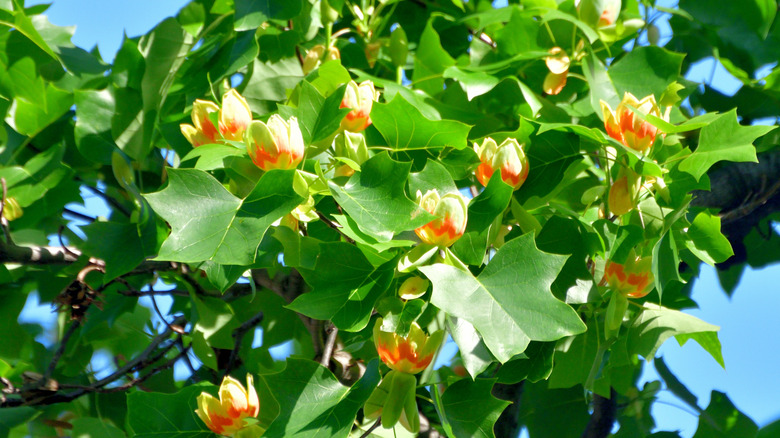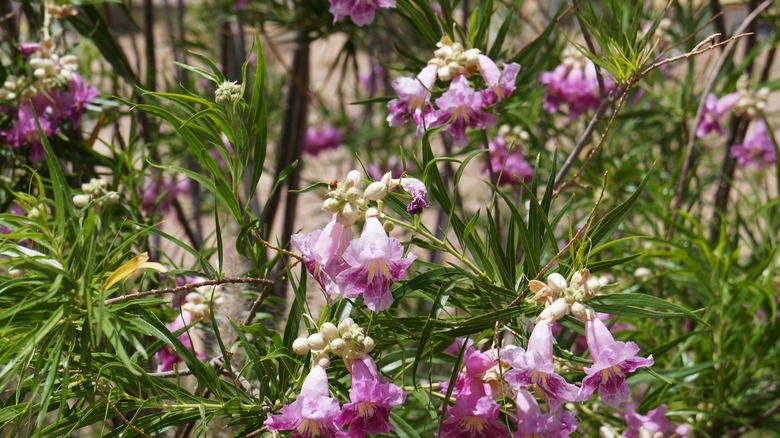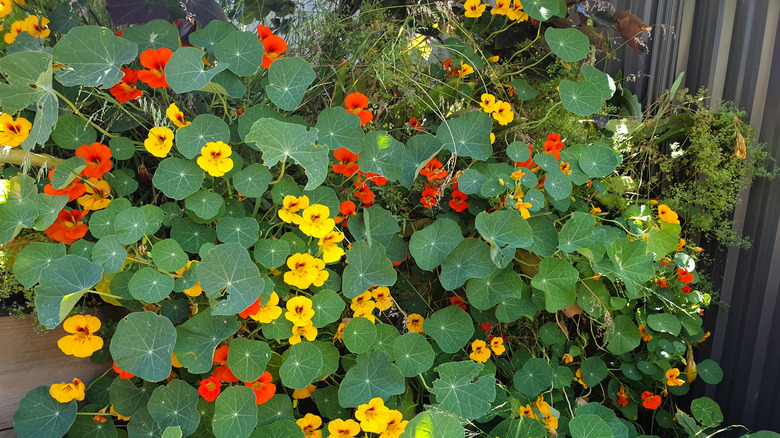Beautiful Hummingbird-Attracting Plants You'll Wish You Never Grew In Your Yard
Planting greenery with hummingbirds in mind is a great way to make your yard a beneficial space for pollinators. They're so cute with their little bodies and hypersonic wing pulses; we could watch them for hours. But they're more than just fun creatures to observe — there are many benefits to attracting hummingbirds to your yard. Plus, there are numerous hummingbird-friendly plant options available to choose from, you really can take your pick, customizing your yard's aesthetics without sacrificing its usefulness for our winged friends.
With so many cultivars available, it can get overwhelming quickly, so let us help you narrow it down a little by giving you a few plants you definitely should steer clear of growing. While these plants can be attractive to hummingbirds, their invasive nature can cause ecological problems or simply make them an overall pain in the butt to deal with, so it's best to avoid planting them and opt for native alternatives instead. Here are some of the most objectively beautiful, but absolutely invasive, hummingbird attractors you'll regret adding to your yard.
Japanese honeysuckle (Lonicera japonica)
Japanese honeysuckle (Lonicera japonica) hails from, you guessed it, Japan (and other areas of Southeast Asia). It's a semi-evergreen vine that's full of fragrant flowers that hummingbirds just love. If you're somewhat of a new gardener or would hardly consider yourself a green thumb, Japanese honeysuckle can make you feel like you've hit "expert level" of some sort of extreme home gardener game (as an aside, why isn't that a thing?), because it's ridiculously hardy, spreading via seeds, underground rhizomes, and above-ground runners. But its will to live is also why it's first on this list, as it's nearly impossible to kill, so much so that it's on several states' lists of "highly invasive species."
Lonicera japonica outcompetes nearly any neighboring plants quickly, growing over them and smothering them out of existence. But it's not only your garden you'd have to worry about; Japanese honeysuckle can grow up to 29 feet high and 6 feet wide, stamping out your neighbor's gardens, too. If you want a vine that produces hummingbird-friendly, highly-fragrant blooms that won't put you on the HOA's naughty list, try Jackman's clematis (Clematis x jackmanii), apricot vine (Passiflora incarnata), or Carolina jessamine (Gelsemium sempervirens).
Bush honeysuckle (Lonicera maackii)
Like its Japanese cousin, the bush honeysuckle (Lonicera maacki) produces crisp white, fragrant blooms that hummingbirds adore. It's also incredibly hardy and highly adaptable, forming a bushy, 15-foot-tall clump of plant that overshadows neighboring plants and keeps them from getting the light they need to photosynthesize. It's like having a 30 story building built right on your property line. Shade, heat, cold, and drought won't kill it, so if you end up planting this, either stop reading this and dig it back up immediately or accept that you're now in a long-term commitment with a honeysuckle plant.
Bush honeysuckle can produce up to one million seeds, making it a particular headache for state forestry departments to curb. That's why they'll beg landscapes to opt for something native or, at the very least, more able to be tamed. If you want a hummingbird-friendly plant that can go toe to toe with bush honeysuckle's pure-white petals and sweet fragrance without the invasiveness, try the sweetbay magnolia (Magnolia virginiana), Daniel Weeks ginger lily (Hedychium), or baneberry.
Chinese privet (Ligustrum sinense)
The Chinese privet (Ligustrum sinense) came to the U.S. in the mid 1800s and took off in the eastern and southern regions, becoming a hummingbird favorite quickly. Unfortunately, hummingbirds weren't the ones that had to take care of it; we soon found out how menacing this pretty shrub could be. Ligustrum sinense can reach 15 feet high and will set up shop in whatever soil conditions you've got; it's not picky. But once it's established, good luck getting rid of it. It's a prolific seeder and will spread suckers that create thickets that overtake native plants easily.
Maybe all of this would be a good trade off if it gave something unique. Well, let's clarify that — if it gave something unique that's positive, because it does have a unique quality: its smell. Chinese privet flowers are extremely fragrant, which some politely refer to as "malodorous," while others straight up just call "foul." If you like the Chinese privet's aesthetics, baneberry (Actaea) or sweet pepperbush (Clethra alnifolia) are near-identical flowers that are much easier to handle.
Mimosa (Albizia julibrissin)
Sorry, we're not breaking out the champagne and orange juice — we're talking about plants. Mimosa (Albizia julibrissin), also known as the "silk tree," has the most incredible wispy, pink flowers that can pepper branches that reach as high as 50 feet. Mimosa trees grow fast, especially in areas where they can be left alone, like grasslands and vacant lots. And while the idea of a giant pink tree might sound appealing to some, mimosas are a holy terror to deal with that you should really think twice before growing. First, their quick spread suffocates native plants easily, ruining your chances for a nearby garden. Not only are they fast growers, but their branches are weak and easily damaged by wind, so the combination of hair-like blooms and fern-like leaves make yard cleanup a never-ending chore. And just to add one more headache to the pile, their seed pods contain deadly alkaloid neurotoxins for livestock and dogs, making your clean-up a mandatory task.
Luckily, there are lots of native plants that can match the mimosa's pretty pink flowers. The everblooming honeysuckle (Lonicera x heckrottii) and common honeysuckle (Lonicera periclymenum) are two good alternatives. We know they might give you pause since they are cousins of two plants mentioned here, but the heckrottii cultivar is considered invasive only in Illinois and periclymenum is currently in the clear. If you'd rather just play it safe and skip the honeysuckle family altogether, mountain azalea (Rhododendron canescens) is an excellent mimosa alternative.
Butterfly bush (Buddleia davidii)
It's sad to see such a pretty plant with an even prettier name be such a nuisance, but the butterfly bush (Buddleja davidii) has definitely earned its spot on this list. What's worse, its name is a little deceptive: While it's true that butterflies are attracted to it and will drink its nectar, caterpillars (pre-butterfly butterflies) cannot and need native plants in order to thrive. Butterflies aren't the only flying friends attracted to this plant either — you guessed it, butterfly bush is a favorite among hummingbirds. Unfortunately, though, its invasive nature wreaks havoc on native flora.
Davidii's clusters of flowers, known as "panicles," can each give off over 40,000 winged seeds, each with a viability of three to five years. There's just no way to get it to stop once it's going, even if you destroy the mother plant. Instead, pick something that plays nicer with local ecosystems, like blue phlox (Philox divaricata), blue sage (Salvia farinacea), or davidii's "good" twin, the English lilac (Syringa vulgaris).
Trumpet creeper (Campsis radicans)
Trumpet creeper (Campsis radicans) looks like the perfect hummingbird plant, right? With its bright orange, upturned trumpet flowers, it's like a big "open for business" sign for hummingbirds. But there's a foreboding in a few of its pseudonyms — devil's shoestring, hellvine, and cow-itch (Okay, Cow-itch has nothing to do with it; we just wanted to point it out because, really? Cow-itch?) — demonstrating it's a tricky plant with potentially deadly consequences. Campsis radicans self-seeds freely, building dense colonies of plants that choke out their neighbors easily. The plant can become so dense and dangerous that it's considered a fire hazard and should not be planted near your home.
Comparatively speaking, Campsis radicans isn't that bad of a plant to grow if you're thoughtful about its growing habits. The plant needs sturdy structures to attach to that can hold its immense weight from the dense foliage, so plant it somewhere that can contain its spread, like a post in the middle of your yard. Pruning or mowing down suckers will also stop its spread, along with concrete barriers. However, if you'd prefer to use flowers that hummingbirds absolutely love and are less flammable (understandably so), try the Poquito orange hyssop (Agastache Poquito Orange 'TNAGAPO'), Florida azalea (Rhododendron austrinum), or hamabo hibiscus (Hibiscus hamabo).
Crabapples (Malus spp.)
Crabapples (Malus spp.) are one of the few native plants on this list, making them noninvasive but still enough of a nuisance that they should stay out of your yard. Despite their offputting names, crabapple trees are gorgeous shrubs in the rose (Roseaceae) family. Hummingbirds love the nectar from the pink and white blooms, but the problems that come along with planting crabapple trees are best saved for the birds. Crabapples are prone to many diseases, fungi, and pests that will happily spread throughout your gardens. Plus, accidentally stepping on a crabapple is like the outdoor version of stepping on a LEGO piece.
There are a few hummingbird-friendly alternatives to crabapple trees, depending on your goals. If you want a medium-sized shrub with pinkish-white flowers, opt for Chinese abelia (Abelia chinensis)or the California buckeye (Aesculus californica). If you'd prefer a fruiting alternative, try a downy hawthorn (Crataegus mollis).
Tulip tree/yellow poplar (Liriodendron tulipifera)
The flowers of the tulip tree or yellow poplar (Liriodendron tulipifera) are truly something to behold. They look like a cupped flame with jagged bands of yellow and orange that hummingbirds can't resist. In the fall, its leaves match the flowers, turning a striking gold that would be hard to miss even if it weren't such a freakishly large tree. That's the biggest problem with Liriodendron tulipifera: It will overtake your yard, and there's nothing you can do to stop it. Tulip tree's trunks reach an impressive 4 to 6 feet in diameter when they mature, and its full height can go as high as 200 feet. There's just no way you're taming that thing or could ever prevent it from being a hazard to your home.
One thing that hummingbirds love about this gorgeous tree is that it makes an excellent place to nest. Luckily, replicating it with something else that attracts hummingbirds and gives them a place to live is easier than you think, as there are compact cultivars now available: Ardis and Compactum. If you'd prefer something a little more shrub-like, try a trumpet flower (Tecoma stans), Chinese tree lilac (Syringa reticulata subsp. pekinensis), or the Japanese tree lilac (Syringa reticulata) for something more cold-hardy.
Desert willow (Chilopsis linearis)
The desert willow (Chilopsis linearis) is another native plant, originating in the Southwestern U.S. and parts of Mexico. Despite its name, it's not related to the willow tree (Salix) — it was just named that due to the resemblance. In desert gardens, Chilopsis linearis does well as a form of natural erosion control, while its pretty purple trumpet flowers bring all the hummingbirds and pollinators to your yard. However, desert willow will self-seed quickly if you're not paying attention — escaping like it's part of a prison break and your neighbor's yard is freedom.
So, rather than having that awkward eye avoidance every time you see them pull into the driveway, either plan to be a vigilant gardener or opt for something easier to manage. Viable alternatives that match desert willow's look and growing conditions are the hummingbird mint (Agastache), Piedmont roseling (Callisia rosea), and most of the Liatris family, but Meadow Blazing Star (Liatris ligulistylis) most of all.
Nasturtium (Tropaeolum majus)
Nasturtium (Tropaeolum majus) comes up pretty often as a workhorse flower for your garden. It's a hardy plant that can guard higher-priority plants from pests, it'll grow just about anywhere, makes an excellent ground cover that prevents pesky weeds, and it's a good-looking flower to boot that attracts all sorts of pollinators, including hummingbirds. But nasturtiums won't be held to your imaginary property lines and will creep, climb, and crawl however they see fit, reaching 10 feet wide and high if you let it. Nasturtiums will happily tolerate drought or neglect and will continue to self-seed readily year-round, making taming them feel more like a game of Whac-A-Mole than a day in the garden.
As compared to others on this list, Tropaeolum majus isn't so objectionable; it just needs rules and physical barriers to keep it under control. If you'd like to grow it, consider putting it in a container or raised garden bed and prune it back regularly. However, if you'd rather deal with something a little more low maintenance with the same hardy nature and showy colors, try butterfly milkweed (Asclepias tuberosa), million bells (Calibrachoa x hybrida), or Mexican zinnia (Zinnia haageana).
